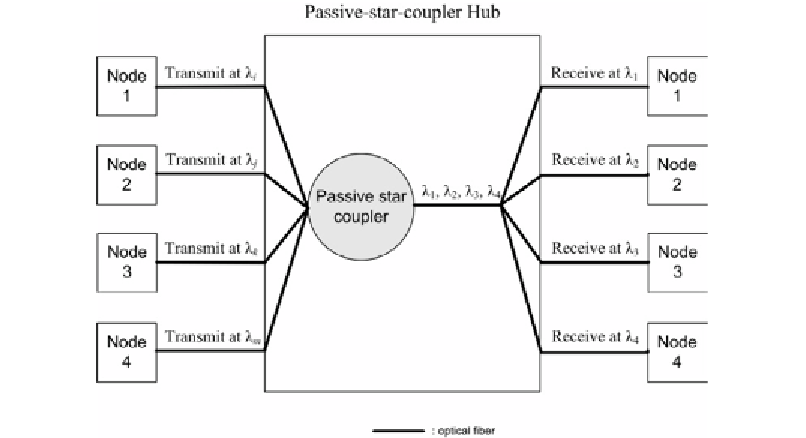Information Technology Reference
In-Depth Information
Figure 2. Example of a passive-star-coupler hub [15-17].
The second type of metro hubs is called AWG hub [3, 18-22]. This metro hub uses an
arrayed waveguide grating (AWG)
to provide one wavelength channel to every input-output
pair, where the AWG is a passive optical component. Figure 3 shows an example of an AWG
hub. This hub can provide more wavelength channels than a passive-star-coupler hub [3, 18-
22]. Because of this advantage, AWG hubs have been studied extensively in the literature [3,
18-22] and implemented as field trials in Europe [18] and Japan [19].
In our recent studies [1-2], we observe two important requirements for metro networks:
1.
Metro networks should be able to transport non-uniform traffic efficiently. It is
because non-uniform traffic is common in many practical scenarios. At the
network edge, the node (e.g., node
N
in Figure 1) has heavier traffic because it
transports the traffic between all the local networks and the backbone network. In
the network core, different regions may have different number of users (e.g., in
some cities, different regions have very different population density) and hence
they may have different traffic volume.
2.
Metro networks should have good scalability (i.e., the networks can easily be
scaled up to provide more channels for the ever-increasing traffic load). It is
because bandwidth demand has been increasing for two reasons: i) there are more
and more users with high-speed access (e.g., provided by Gigabit Ethernet or
optical access networks), and ii) there are more and more bandwidth-demanding
applications (e.g., multimedia entertainment services, content distribution, virtual
private networks, grid computing, etc.). In fact, the Internet traffic was doubling
every six months in the past few years [23], and it is envisioned that the
bandwidth demand will grow exponentially in the coming 20 years [24].

